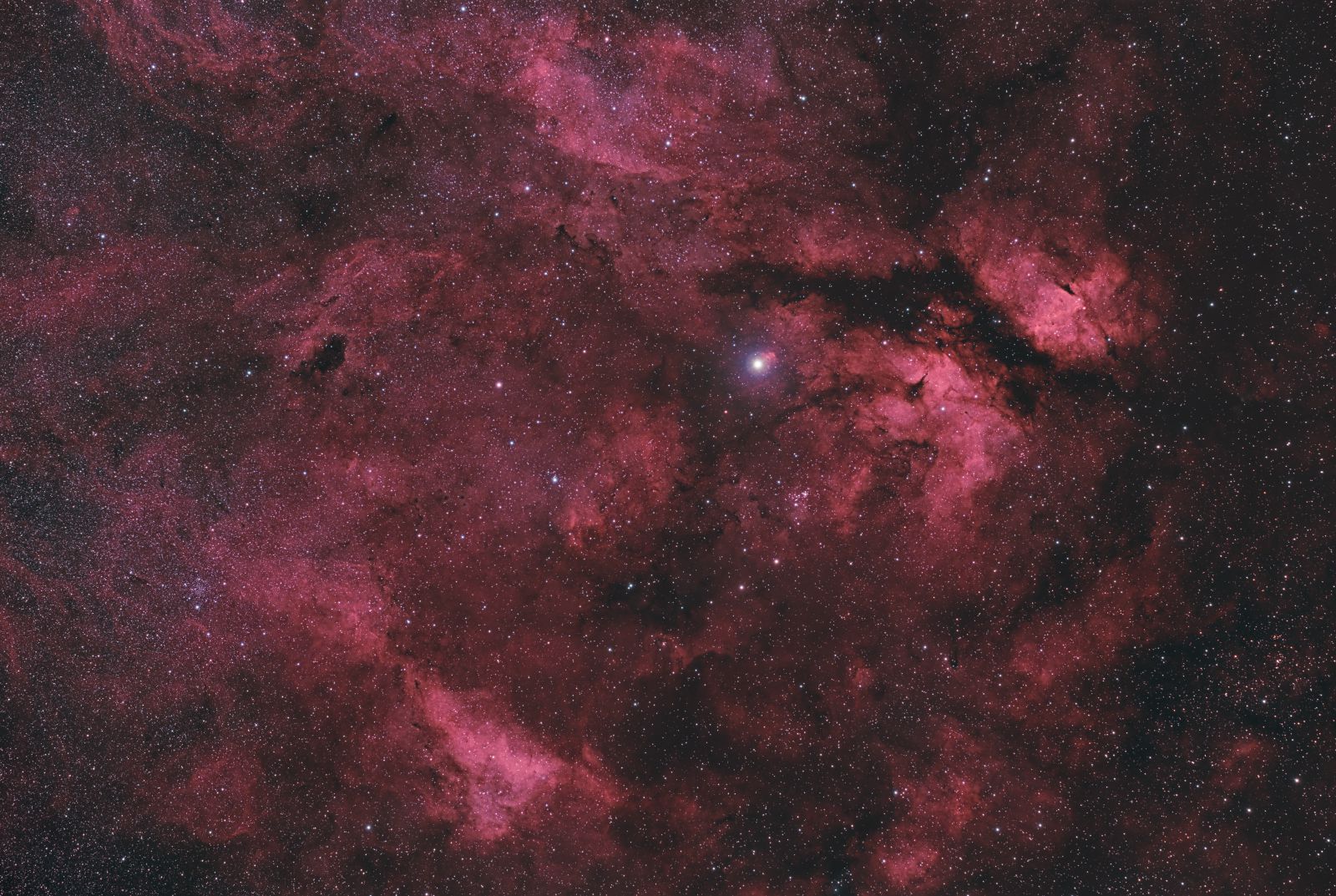γ-Cygni Wide Field
 Click here for full size image
Click here for full size image
October 20, 2019
There is so much going on this field of nebulosity in Cygnus! IC1318 is the brightest patch of nebula in this image, to the upper right of gamma Cygni (γ-Cyg, Sadr), which is the brightest star in this image. Sadr is a naked-eye star, sitting where the body and wings of Cygnus, the Swan, cross in the sky. The nebulosity in this region seems to form a ring, which is not centred on Cygnus is up very high in the sky in the summer and fall. Despite its appearance in this image, this nebula is actually faint and tenuous visually — the brightest parts are visible in a dark sky with a big telescope, but they look just like a faint haze in the eyepiece. It is challenging to see faint objects in this field through a telescope unless you keep Sadr out of the eyepiece field of view.
To me, the nebulosity in this regions seems to form a ring, suggesting that there was a star collapse or supernova at the ring’s centre. Also note the pretty star clusters in the image. NGC 6910 is below and slightly right of Sadr. IC 1311 is the rich open cluster towards the left of the image, and below centre. The triangular patch of nebulosity is LBN 251, and I have imaged it before. I’ve also imaged IC 1318 at higher resolution.
Tekkies:
Takahashi FSQ-106 ED IV @ f/3.6, QHY367C one-shot colour camera, and Optolong L-eNhance narrowband filter, Paramount MX, unguided. Acquisition, and focusing with TheSkyX. Focus with Optec DirectSync focus motor and controller. Automation with CCDCommander. Equipment control with PrimaLuce Labs Eagle 3 Pro computer. All pre-processing and processing in PixInsight. Acquired from my SkyShed in Guelph. Waning crescent Moon, average to above average transparency and fair to average seeing. Data acquired September 25-October 11, 2019.
122x10m with Optolong L-eNhance filter (Total = 20hr20m)
Image scale 2.6 arcsec per pixel
Data Reduction and Cleanup
Preprocessing: The BatchPreProcessing script was used to perform calibration, debayering, and registration of all frames. ImageIntegration followed by DrizzleIntegration with the CFA Drizzle option was used to make the master, which was then cropped.
Gradient Removal: Gradient removal was not necessary.
Channel Registration: To improve channel registration, the RGB colour channels were extracted and aligned with StarAlignment, using Thin Plate Splines with Distortion Correction and the green channel as the reference frame. The registered colour channels were recombined with ChannelCombination.
Luminance Extraction: RGBWorkingSpace was applied to normalize the channels, and the Luminance was extracted for separate processing as described below.
Colour
Colour Balancing: The colour image was colour balanced with ColorCalibration.
Linear Noise Reduction: MultiscaleLinearTransform was used to reduce noise in the background areas, using an internal mask to protect bright structures. Layer settings for threshold and strength: Layer 1: 5.0 0.75 Layer 2: 3.0, 0.70 Layer 3: 2.0, 0.6 Layer 4: 1.0, 0.2.
Stretching: HistogramTransformation was applied to make a pleasing, bright image, with background set to an intensity of approximately 0.10.
Luminance
Linear Noise Reduction: MultiscaleLinearTransform was used to reduce noise in the background areas, using an internal mask to protect bright structures. Layer settings for threshold and strength: Layer 1: 3.0 0.9 Layer 2: 2.0, 0.75 Layer 3: 1.0, 0.6 Layer 4: 0.5, 0.2.
Stretching: HistogramTransformation was applied to make a pleasing, bright image, with background set to an intensity of approximately 0.10.
Recombining Luminance and RGB
LRGB Combination: The luminance image was applied to the RGB image using LRGBCombine with default settings.
Additional Processing
Nonlinear Noise Reduction: TGVDenoise was used in L*a*b* mode to reduce noise with a mask used to target the background areas and protect the stars (max. 1000 iterations and convergence selected for both lightness and chrominance).
Contrast Enhancement: LocalHistogramEqualization was applied twice (scale of 50 with strength 0.35; then scale of 150 with strength 0.25) using a mask to protect stars and low-signal regions of the image.
Final Steps: Background, nebula and star brightness, contrast, hue and colour saturation were adjusted in several iterations using CurvesTransformation with masks as required. The DarkStructureEnhance script was applied with a strength of 0.2. The image was rescaled to its original scale of 2.6″/pixel.






Leave A Comment